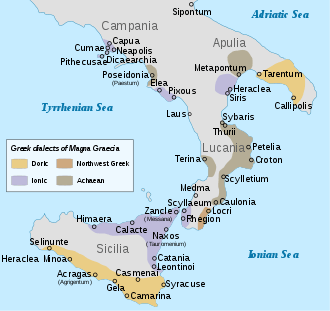Otranto
Otranto (UK: /ɒˈtræntoʊ/,[3] US: /oʊˈtrɑːntoʊ/,[4][5] Italian: [ˈɔːtranto]; Salentino: Uṭṛàntu; Griko: Δερεντό, romanized: Derentò; Ancient Greek: Ὑδροῦς, romanized: Hudroûs; Latin: Hydruntum) is a town and comune in the province of Lecce (Apulia, Italy), in a fertile region once famous for its breed of horses.
Otranto | |
|---|---|
| Comune di Otranto | |
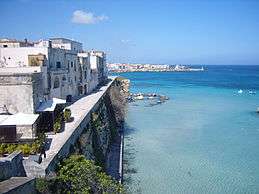 Otranto seen from the castle | |
 Coat of arms | |
Location of Otranto 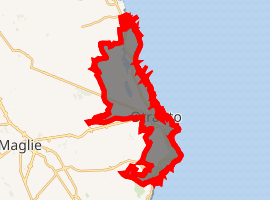
| |
 Otranto Location of Otranto in Italy  Otranto Otranto (Apulia) | |
| Coordinates: 40°09′N 18°29′E | |
| Country | Italy |
| Region | Apulia |
| Province | Lecce (LE) |
| Frazioni | Porto Badisco, Conca Spellucchia |
| Government | |
| • Mayor | Pierpaolo Cariddi |
| Area | |
| • Total | 77.2 km2 (29.8 sq mi) |
| Elevation | 15 m (49 ft) |
| Population (31 December 2017)[2] | |
| • Total | 5,800 |
| • Density | 75/km2 (190/sq mi) |
| Demonym(s) | Idruntini or Otrantini |
| Time zone | UTC+1 (CET) |
| • Summer (DST) | UTC+2 (CEST) |
| Postal code | 73028 |
| Dialing code | 0836 |
| Patron saint | Blessed Otrantine Martyrs |
| Saint day | August 14 |
| Website | Official website |
It is located on the east coast of the Salento peninsula. The Strait of Otranto, to which the city gives its name, connects the Adriatic Sea with the Ionian Sea and separates Italy from Albania. The harbour is small and has little trade.
The lighthouse Faro della Palascìa, at approximately 5 kilometres (3 miles) southeast of Otranto, marks the most easterly point of the Italian mainland.
About 50 kilometres (31 mi) south lies the promontory of Santa Maria di Leuca (so called since ancient times from its white cliffs, leukos being Greek for white), the southeastern extremity of Italy, the ancient Promontorium lapygium or Sallentinum. The district between this promontory and Otranto is thickly populated and very fertile.
History

Otranto occupies the site of the ancient Greek city Hydrus (in Greek: Ὑδροῦς) or Hydruntum (in Latin), also known as Hydrunton, Hydronton, or Hydruntu. Otranto was a town of Messapian origin (Illyrian) , which, in the wars of Pyrrhus and of Hannibal sided against Rome.
In Roman times it was a city. As it is the nearest port to the eastern coast of the Adriatic Sea, it was perhaps more important than Brundisium (present Brindisi), under the Roman emperors as a point of embarkation for the East, as the distance to Apollonia, (present Albania) was less than from Brundisium.
In the 8th century, it was for some time in the possession of duke Arechis II of Benevento. It remained in the hands of the Byzantine emperors until it was among the last cities of Apulia to surrender to the Norman Robert Guiscard in 1068, and then became part of the Principality of Taranto. In the Middle Ages the Jews had a school there.
Ottoman invasion

In 1480, Mehmet the Conqueror sent an Ottoman fleet to invade Rome under the command of Gedik Ahmed Pasha. This force reached the shores of Apulia on 28 July 1480 and the city was captured in two weeks on 11 August 1480. Some 800 citizens, known as the "Martyrs of Otranto," were beheaded after refusing to convert to Islam. They were canonized by Pope Francis on 12 May 2013.[6]
Between August and September 1480, the Italian and European kingdoms failed to help King Ferdinand of Naples, except his cousin Ferdinand the Catholic, the Kingdom of Sicily and, later, the Republic of Genoa.[7] In 1481, the Pope, in panic, called for a crusade to be led by King Ferdinand of Naples, and was joined by troops of Hungarian king Matthias Corvinus. The Turks controlled the city for 13 months. Mehmet II died on his way to capture the rest of Italy.[8] His successor, Bayezid II, ordered Gedik Ahmed Pasha to be hanged and on 11 September 1481 the Turks abandoned the city.
In 1537, the famous Turkish corsair and Ottoman admiral Barbarossa recaptured Otranto and the Fortress of Castro, but the Turks were again repulsed from the city and from the rest of Apulia.
Napoleonic Wars
In 1804, the city was obliged to harbour a French garrison that was established there to watch the movements of the English fleet. Under the French name of Otrante it was created a duché grand-fief de l'Empire in the Napoleonic kingdom of Naples for Joseph Fouché, Napoleon's minister of Police (1809), the ancestor of Margareta Fouché. The family used the title of duc d'Otrante after Joseph Fouché's death.
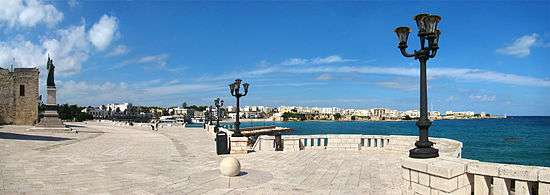
World War I
During WWI the allied Italian-French-British Fleet organized the Otranto Barrage to control the Austro-Hungarian Fleet in the Adriatic Sea. The Austro-Hungarian Fleet led by captain Miklós Horthy attacked the Barrage (13 -15 May 1917) breaking it and sinking some British drifters (Battle of the Strait of Otranto (1917)).[9]
World War II
During WWII the British fleet raided the Otranto Channel (11-12 November 1940) as a diversionary manoeuvre (Battle of the Strait of Otranto (1940) from the contemporary main attack on Taranto (Battle of Taranto)[10]
Geography
Climate
Otranto experiences a Humid subtropical climate (Köppen climate classification Cfa).
| Climate data for Otranto | |||||||||||||
|---|---|---|---|---|---|---|---|---|---|---|---|---|---|
| Month | Jan | Feb | Mar | Apr | May | Jun | Jul | Aug | Sep | Oct | Nov | Dec | Year |
| Average high °C (°F) | 13.0 (55.4) |
13.5 (56.3) |
15.7 (60.3) |
18.9 (66.0) |
24.4 (75.9) |
27.0 (80.6) |
28.7 (83.7) |
28.5 (83.3) |
25.8 (78.4) |
22.3 (72.1) |
17.3 (63.1) |
14.0 (57.2) |
20.8 (69.4) |
| Average low °C (°F) | 7.2 (45.0) |
8.2 (46.8) |
9.6 (49.3) |
10.0 (50.0) |
12.1 (53.8) |
15.9 (60.6) |
21.2 (70.2) |
21.1 (70.0) |
16.0 (60.8) |
12.7 (54.9) |
10.3 (50.5) |
8.3 (46.9) |
12.7 (54.9) |
| Average precipitation mm (inches) | 52 (2.0) |
60 (2.4) |
81 (3.2) |
83.3 (3.28) |
83.6 (3.29) |
110.7 (4.36) |
85.8 (3.38) |
67.5 (2.66) |
114.6 (4.51) |
100.2 (3.94) |
80.7 (3.18) |
53.3 (2.10) |
972.2 (38.28) |
| Average precipitation days | 6.7 | 7.1 | 8.2 | 8.1 | 6.9 | 7.3 | 5.8 | 5.1 | 7.7 | 7.5 | 7.2 | 6.6 | 84.2 |
| Source: Italian Ministry of Defence[11] | |||||||||||||
Main sights
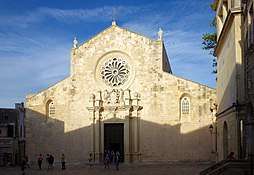
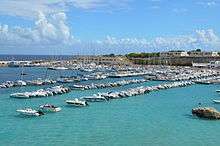
Otranto main sights include:
- The Castello Aragonese (Castle), reinforced by Emperor Frederick II and rebuilt by Alphonso II of Naples in 1485–98. It has an irregular plan with five sides, with a moat running along the entire perimeter. In origin it had a single entrance, reachable through a draw-bridge. Towers include three cylindrical ones and a bastion called Punta di Diamante ("Diamond's Head"). The entrance sports the coat of arms of Emperor Charles V.
- The Cathedral, consecrated in 1088, a work of Count Roger I adorned later (about 1163), by Bishop Jonathas, with a mosaic floor; it has a rose window and side portal of 1481. The interior, a basilica with nave and two aisles, contains columns said to come from a temple of Minerva and a fine mosaic pavement of 1166, with interesting representations of the months, Old Testament subjects and others. Bones and relics of the Martyrs of Otranto, who perished in the 15th-century siege surround the high altar. The church has a crypt supported by 42 marble columns. The same Count Roger also founded a Basilian monastery here, which, under Abbot Nicetas, became a place of study; its library was nearly all bought by Bessarion.
- The church of San Pietro, with Byzantine frescoes.
- The catacombs of Torre Pinta.
- Idro, a small river which the toponym Otranto stems from.
Culture
Otranto is the setting of Horace Walpole's book, The Castle of Otranto, which is generally held to be the first Gothic novel. Walpole had chosen the town from a map of the Kingdom of Naples because the name was "well sounding"; he was not aware that Otranto had a castle until 1786, some twenty-two years after the novel was first published under a pseudonym. The principal model for the castle was his villa in Strawberry Hill, London.[12]
Otranto is also mentioned in Bram Stoker's novel The Lady of the Shroud.
International relations
See also
- Bishopric of Otranto
- Otranto Tragedy
- Ottoman invasion of Otranto
Sources and references


- Heraldica.org- Napoleonic
- GigaCatholic
External links
| Wikimedia Commons has media related to Otranto. |
| Wikivoyage has a travel guide for Otranto. |
References
- "Superficie di Comuni Province e Regioni italiane al 9 ottobre 2011". Istat. Retrieved 16 March 2019.
- "Popolazione Residente al 1° Gennaio 2018". Istat. Retrieved 16 March 2019.
- "Otranto, Strait of". Lexico UK Dictionary. Oxford University Press. Retrieved 4 July 2019.
- "Otranto". The American Heritage Dictionary of the English Language (5th ed.). Boston: Houghton Mifflin Harcourt. Retrieved 4 July 2019.
- "Otranto". Collins English Dictionary. HarperCollins. Retrieved 4 July 2019.
- "Pope canonises 800 Italian Ottoman victims of Otranto". BBC. BBC. 12 May 2013. Retrieved 12 May 2013.
- G. Conte, Una flotta siciliana ad Otranto (1480), in "Archivio Storico Pugliese", a. LXVII, 2014
- http://www.yazaroku.com/fsanat-kultur/ilber-ortayli/07-08-2011/guney-italya-ve-osmanlilar/369717/.aspx
- Carlo Stasi, Otranto e l'Inghilterra (episodi bellici in Puglia e nel Salento), in Note di Storia e Cultura Salentina, anno XV, pp. 127–159, (Argo, Lecce, 2003), Paul G. Halpern, The Battle of the Otranto Straits (controlling the Gateway to the Adriatic in WWI) (Bloomington, I.U.P. 2004).
- Carlo Stasi, Otranto e l'Inghilterra (episodi bellici in Puglia e nel Salento), in Note di Storia e Cultura Salentina, anno XV, pp. 127–159, (Argo, Lecce, 2003), Carlo Stasi, Otranto nel Mondo. Dal "Castello" di Walpole al "Barone" di Voltaire (Editrice Salentina, Galatina 2018) ISBN 978-88-31964-06-7, Thomas P. Lowry, The Attack on Taranto (Stackpoole Books paperbacks, 2000)
- Lecce-Galatina weather station Italian Ministry of Defence Retrieved 2009-06-02
- Walpole, Horace; Clery, E.J. (2008) [1764]. Lewis, W.S. (ed.). The Castle of Otranto (Oxford World's Classics ed.). Oxford: Oxford University Press. p. 117. ISBN 9780199537211., Carlo Stasi, Otranto nel Mondo. Dal "Castello" di Walpole al "Barone" di Voltaire (Editrice Salentina, Galatina 2018) ISBN 978-88-31964-06-7,

